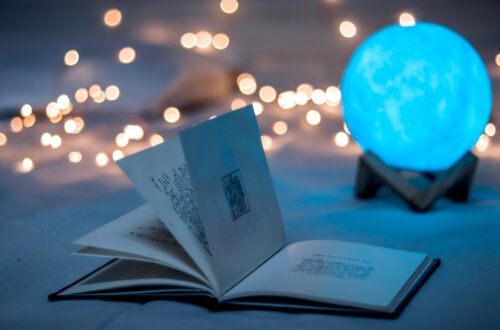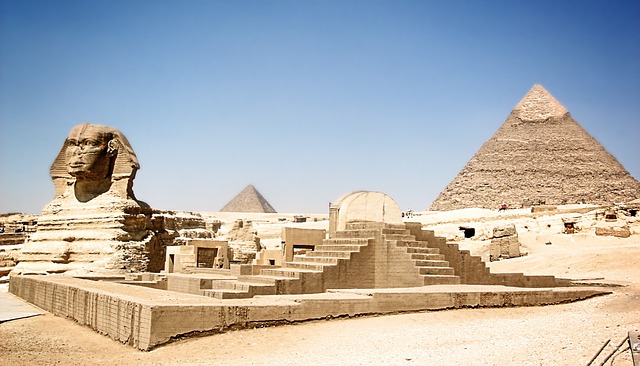
Famous Egyptian Goddesses of Love: Isis, Hathor, and Their Significance
Table of Contents
The ancient Egyptian pantheon is filled with deities that represented various aspects of life, love, and the cosmos. Among the most revered were the goddesses associated with love, fertility, and the nurturing aspects of human life. Two of the most prominent goddesses in this context were Isis and Hathor. These deities played essential roles in the everyday lives of ancient Egyptians, embodying powerful forces of nature, femininity, and affection. Their worship, myths, and symbols have left a lasting legacy, both in ancient religious practices and in modern interpretations of mythology.
Read: https://magical-rituals.com/blog/2024/10/14/homemade-love-spells-that-work/
This article explores the significance of Isis and Hathor, their roles as goddesses of love, and their broader influence on Egyptian culture.
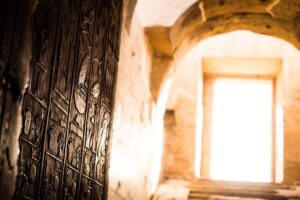
The concept of love in ancient egyptian religion
Love, fertility, and divine forces
In ancient Egypt, love was seen as a divine gift, something that could be influenced by the gods and goddesses. It was intertwined with ideas of fertility, creation, and harmony. Relationships between humans were often viewed as reflections of the interactions between the gods themselves, many of whom were involved in romantic and familial relationships.
Egyptians believed that gods and goddesses played active roles in shaping human affairs, including matters of the heart. Love was not limited to romantic feelings but extended to familial bonds, the love between friends, and the affection between humans and the gods. To the Egyptians, love was a powerful force that sustained both the physical and spiritual realms, and the goddesses of love, such as Isis and Hathor, were seen as protectors and promoters of these essential bonds.
Isis: The universal mother and sorceress
Origins and attributes of Isis
Isis, known as one of the most important deities in the Egyptian pantheon, was worshipped as the ideal mother, wife, and embodiment of magic. Her origins are deeply connected with the creation myths of Egypt, where she plays a key role in the Osirian cycle, which tells the story of her love for her husband Osiris and her efforts to restore him after his death. Isis was not only the goddess of love and motherhood but also a goddess of healing, magic, and protection.
Her attributes as a goddess were manifold, and she was considered the most powerful magician among the gods. She was often depicted wearing a throne-shaped crown or the solar disk with cow horns, reflecting her status and association with other prominent deities like Hathor. Over time, she absorbed the characteristics of many other goddesses, making her a universal figure in Egyptian religion.
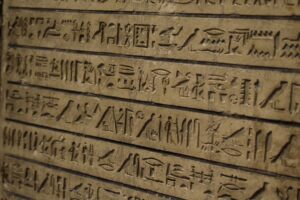
Isis as a Goddess of Love
Isis was revered for her unwavering love for her husband, Osiris. Her mythic journey to retrieve Osiris’ body after he was murdered by his brother Set is a story of profound devotion and love. This narrative not only emphasizes her role as a loyal wife but also her ability to transcend death, highlighting love’s eternal power. Isis’ determination to restore Osiris to life so that they could conceive their son, Horus, showcases her role in fertility and the creation of life.
In love magic, Isis was often invoked for her protective qualities, especially for couples seeking to strengthen their relationship or for women hoping to conceive. Her association with fertility and the afterlife made her a figure of immense importance in rituals and prayers concerning family, childbirth, and marital love.
The Cult of Isis and Its Influence
The cult of Isis spread far beyond Egypt, especially during the Greco-Roman period, where she became one of the most widely worshipped deities across the Mediterranean. Her appeal as a goddess of love, protection, and magic made her worshippers devoted, with temples dedicated to her as far as Rome and Greece.
Her influence can still be seen today, as her image of motherhood, magic, and love has permeated various cultures, influencing later religious figures and deities, including depictions of the Virgin Mary in Christianity.
Hathor: The Goddess of Joy, Beauty, and Love
Origins and attributes of Hathor
Hathor, often associated with love, beauty, music, and joy, was one of the most ancient and revered goddesses in Egyptian mythology. Her name means “House of Horus,” which refers to her role as a mother or protector of Horus, but she also embodied the celestial aspect of the sky and stars. Hathor’s worship can be traced back to early dynastic Egypt, where she was honored as a cow goddess, symbolizing motherhood and fertility.
Hathor was often depicted as a cow or a woman with cow’s ears or horns, holding a sistrum, a musical instrument associated with joy and festivity. Her close association with music and dance made her a patroness of love, celebration, and sensuality. She was also seen as a deity of drunkenness, fertility, and the arts, overseeing all things that brought happiness and beauty into the world.
Hathor as a Goddess of love and fertility
As a goddess of love, Hathor’s influence was wide-reaching, and she was invoked in matters of romantic love, fertility, and childbirth. Hathor’s nurturing nature made her a goddess of both passionate and familial love. Her festivals often involved joyful celebrations, music, and dancing, reflecting the joy and fulfillment associated with love and affection.
In ancient Egyptian society, Hathor’s role as a fertility goddess was especially important. Women who wished to conceive or those seeking to ensure a safe childbirth would often pray to Hathor for her blessings. She was seen as the protector of mothers and children, and her milk was believed to nourish both gods and humans.
Hathor also played a role in matchmaking and the romantic lives of individuals. In some texts, Hathor is seen guiding people towards their romantic destinies, aligning human relationships with the divine will. Her presence was thought to bring harmony and joy to couples, ensuring that their relationships were not only fruitful but also filled with love and mutual affection.
The Festivals of Hathor: Celebrations of love and joy
Hathor’s festivals were some of the most joyous and celebrated events in ancient Egypt. These festivals, often held in her honor, included music, dance, and feasting, embodying the very essence of life and love. One of the most famous festivals was the “Festival of Drunkenness,” which celebrated Hathor’s role in bringing joy and fertility to the land. During these festivals, revelers would drink and dance in a state of ecstatic celebration, invoking Hathor’s blessings for love, fertility, and happiness.
Temples dedicated to Hathor, such as the one at Dendera, were centers for these celebrations. Pilgrims from all over Egypt would come to offer prayers and gifts to the goddess, seeking her favor in matters of the heart, fertility, and family. These temples were often filled with music and art, reflecting Hathor’s influence over these creative aspects of life.
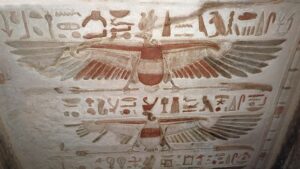
The relationship between Isis and Hathor
Shared symbolism and attributes
Isis and Hathor, while distinct deities, shared many overlapping attributes, particularly as goddesses of love, motherhood, and fertility. Both were seen as protectors of women, mothers, and children, and both played vital roles in matters of the heart. They were often depicted together or with similar symbols, such as the cow horns and the solar disk, highlighting their close relationship in the Egyptian pantheon.
Hathor, being an older deity, was sometimes absorbed into the figure of Isis as the latter’s popularity grew. This fusion of characteristics led to Isis adopting many of Hathor’s symbols and roles, particularly in the realms of beauty, joy, and fertility. Over time, Isis came to be seen as a universal goddess, encompassing not only her original roles but also the attributes of other goddesses, including Hathor.
Differences in their roles
Despite their shared traits, Isis and Hathor had distinct roles in Egyptian mythology and religious practices. Isis was primarily known for her magic, wisdom, and her role in the myth of Osiris and Horus, which gave her a more complex and multifaceted persona. She was the archetype of the devoted wife and mother, whose love transcended death itself.
Hathor, on the other hand, was more directly associated with physical love, joy, and celebration. She was seen as a goddess of beauty and sensuality, and her festivals were marked by music, dancing, and revelry. While Isis’ love was often depicted in terms of devotion and protection, Hathor’s love was more aligned with the pleasures of life and the enjoyment of human relationships.
The legacy of Isis and Hathor
Influence on egyptian society
The worship of Isis and Hathor had a profound impact on ancient Egyptian society. These goddesses not only represented divine love and protection but also embodied the ideal qualities of womanhood. Women in ancient Egypt often looked to these goddesses as role models for strength, devotion, and nurturing.
Both Isis and Hathor were also symbols of fertility, and their worship was central to rituals and prayers concerning childbirth and family life. In a society where family and continuity were of paramount importance, these goddesses were venerated as essential protectors of domestic and familial harmony.
Modern interpretations and cultural impact
Even today, Isis and Hathor continue to capture the imagination of people around the world. Isis, in particular, has become a symbol of resilience, magic, and the power of love. Her image has been adapted in various modern contexts, from literature and popular culture to spiritual movements that celebrate her as a goddess of feminine power.
Hathor’s influence, too, can be seen in modern representations of love and beauty. As a symbol of sensuality and joy, Hathor continues to inspire art, music, and dance in contemporary culture. Both goddesses, with their deep connections to love and the divine feminine, have transcended the boundaries of ancient Egypt to become universal symbols of love, beauty, and the nurturing aspects of life.
Conclusion
Isis and Hathor stand as two of the most significant goddesses in ancient Egyptian mythology, each embodying different aspects of love, motherhood, and feminine power. While Isis represents devotion, protection, and the eternal nature of love, Hathor embodies the joy, beauty, and sensuality of human relationships. Together, these goddesses provided ancient Egyptians with a divine model for understanding love in all its forms, from the nurturing care of a mother to the passionate bonds between lovers. Their legacy continues to influence modern interpretations of love, fertility, and the power of the feminine divine.
Bibliography:
1. “This 1,300-Year-Old Egyptian ‘Love Spell’ Has Finally Been Deciphered” – ScienceAlert. This article explores the decoding of an ancient magical text believed to be used for invoking love.
2. “Ancient Egyptian Handbook of Spells Deciphered” – Live Science. A deep dive into a collection of spells, including those aimed at love, from a codex dating back to early Christian Egypt.
3. “The Ancient Egyptian Magic Guide” – Egypt Mythology. This guide details the rituals and spells of ancient Egypt, including love-related incantations.
4. “The Ancient Egyptian Book of Love” – Egypt Mythology. An overview of love spells invoking deities like Hathor and Bastet, emphasizing the power of words and offerings in love magic.
5. “Egyptian Incantation Handbook Decoded” – The Times of Israel. An article on a newly deciphered handbook containing spells, including those for attracting love.



